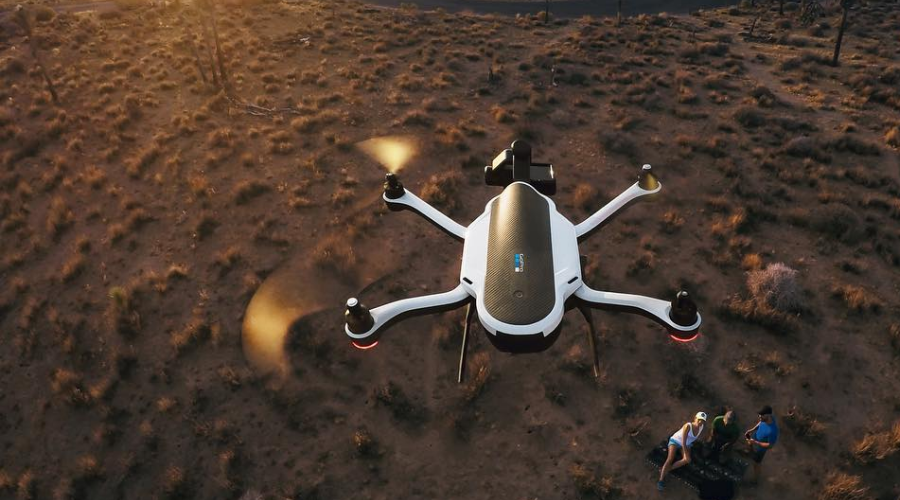By Thomas J. Ryan
At a lavish event at a ski resort on Monday in Squaw Valley, CA, GoPro Inc. unveiled two new cameras, the Hero5 Black and the Hero5 Session, and its first long-anticipated drone, the Karma.
In July, GoPro officials said it expected the new products, launching in time for holiday selling, to help it jump-start growth and restore profitability.
Much of the attention around the launches went to the Karma, which folds to fit into a backpack. Priced at $799, the Karma features a detachable camera stabilizer as well as a game-style controller with a display to show the live feed from the drone’s camera.
“Karma is a lifestyle product that will allow anyone to capture amazingly smooth, stabilized video during almost any activity,” said Brian McGee, GoPro’s CFO, on a conference call with analysts. “Its painless out-of-the-box experience is unlike any other drone in the market, equipped with linear caption mode for cinematic aerial capture, a game style controller with an integrated test display, image stabilization capabilities that can be removed from the device and used as a handheld gimbal, and the unit is so compact and foldable that the entire system fits into an easy-to-carry backpack.”
The drone was expected to launch in the spring but was delayed in part to make sure the camera stabilizer worked smoothly.
“We felt the consumer deserved that we take a little bit of extra time to nail it,” GoPro CEO Nick Woodman said. He added that GoPro decided to launch its drone as an accessory that works with its other cameras in part because of the savings provided to consumers.
“That is a terrific value for the consumer and it also makes Karma a very simple out-of-box experience akin to a drone with an integrated camera for customers that don’t already have a GoPro,” Woodman said. “So in that sense, it is an accessory for existing customers and Karma is also an out-of-box flying and stabilized camera for a new customer. So we cover both of those bases.”
Finally, he underscored Karma’s versatility versus other drones in the marketplace.
“It is not just a drone,” said Woodman. “It is also a handheld stabilization that you can mount to gear, vehicles, equipment and more, to capture all of the same perspectives that you would capture with simply a GoPro but with incredible stabilization. So we think we are really hitting the mark.”
The Karma will be introduced at select retailers on October 23.
GoPro’s drone will do battle with a market that’s been dominated by Chinese manufacturer SZ DJI Technology Co. and numerous upstarts flooding the market with less-expensive drones. While largely a novelty so far, Grand View Research earlier predicted that the size of the consumer drone market would reach $4.19 billion by 2024, up from $355.9 million in 2015, helped by new safety features and government regulations.
But the launch of GoPro’s new flagship camera, the Hero5 Black, and entry-level camera, the Hero5 Session, are equally important to revive sales of its core product following the disappointing launch of its first entry-level camera, the Hero4 Session, last year.
GoPro has admitted that it initially set Session’s price too high and its software was too complex to reach its intended broader audience. The new cameras address many of those problems. For example, content automatically uploads to the cloud when plugged in, and editing software syncs images to music.
At $399, the Hero5 Black is aimed at GoPro’s core audience of extreme athletes and includes a two-inch touch display. Designed for more conventional uses, such as urban settings and family events, the smaller Hero4 Session shoots lower-resolution photos and will cost $299. Both waterproof cameras hit retail at all GoPro dealers on October 2.
Demand for GoPro’s cameras are being challenged by the increasing quality and ubiquity of smartphone cameras.
GoPro also unveiled a cloud-based subscription software service, GoPro Plus, that simplifies the capturing, editing and sharing of content. A GoPro Plus subscription is $4.99 a month, also starting October 2.
The addition of the new products doesn’t affect GoPro’s 2016 revenue and margin outlook, McGee said on the call. The company remains on track to hit its revenue guidance for this year of between $1.35 billion and $1.5 billion and its target for second-half margins at about 40 percent. McGee also said the company had an opportunity to improve margins in the future with drones.
“We just made a flying robot,” said McGee. “We don’t have 14 years of experience on our flying robot. So we have opportunities to continue to improve margins there.”
With the drone’s postponed release earlier this year and the Hero4’s disappointment, GoPro’s shares have taken a big hit since its strong IPO in 2014. Its stock has tumbled 17 percent in the past year through September 16 and is down almost 85 percent from its October 2014 high. On September 19, shares rose 9.9 percent to $16.44 on the launches.
Photo courtesy GoPro
















